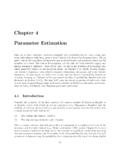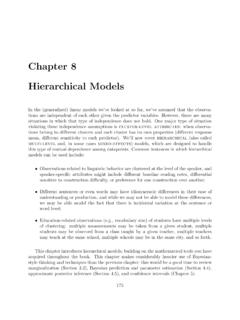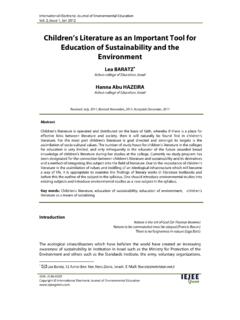Transcription of Cognitive development in deaf children: the interface of ...
1 2002 Elsevier Science All rights reservedHandbook of Neuropsychology, 2nd Edition, Vol. 8, Part Segalowitz and I. Rapin (Eds)CHAPTER 4 Cognitive development in deaf children : the interface oflanguage and perception in neuropsychologyRachel I. Mayberry*School of Communication Sciences and Disorders, McGill University, 1266 Pine Avenue West, Montreal, PQ H3G 1A8, CanadaIntroductionWhat does the sense of hearing contribute to humandevelopment? To answer the question, we must askwhat the sense of hearing gives the child. Hearinggives the child the acoustic correlates of the physicalworld: approaching footsteps, dog barks, car horns,and the pitter-patter of rain.
2 Hearing also allowsthe child to revel in the patterned complexity of aBeethoven symphony or a mother s lullaby. Childrenwho are born deaf clearly miss a great deal. How-ever, hearing conveys much more to the growingchild than the acoustics of the physical world. Hear-ing is the sensory modalitythrough which childrenperceive speech the universe of talk that ties in-dividuals, families and societies together. Childrenborn with bilateral hearing losses that are severe(70 89 dB loss) or profound (>90 dB loss) are re-ferred to as deaf .
3 They cannot hear conversationalspeech (approximately 60 dB) and consequently donot spontaneously learn to talk. Indeed, not talkingat the right age is one of the first signs that a childcannot primary consequence of childhood deafnessis that it blocks the development of spoken language both the acts of speaking and fact leads us to ask what spoken languagecontributes to the child s Cognitive development . Be- Corresponding author. Tel.:+1-514-398-4141;E-mail: deafness impedes the development of spokenlanguage, we must ask whether complex and logi-cal thought can develop in the absence of spokenlanguage.
4 Can the child develop inner thought orworking memory withoutthe ability tohear? Con-sider sign language. Can sign language foster thesame kinds of abstract mental development and com-plex thought asspeech? Now consider an even morecomplex situation, namely, the Cognitive develop-ment of children who grow up with little or noexposure to any language in any form, be it signed orspoken, as a simple consequence of being born are the effects of such linguistic and socialisolation on the child s development of a mental life?
5 Each of these questions has been asked aboutdeaf children in one form or another since the be-ginning of philosophical inquiry (Lane, 1984). Atfirst glance, the answers would seem to be straight-forward and, historically, have been treated as , as we shall see, the answers to these ques-tions quickly become complex for several , Cognitive development entails more than matu-ration of the child s brain. Cognitive development isthe product of the child s attempts to understand thefamily, neighborhood, school and the world at largeduring this period of rapid brain growth and learn-ing.
6 The effects of deafness on Cognitive develop-ment are, therefore, quite diverse and complex due tothe multitudinous ways in which families, societies,and cultures, react to and interact with children whoare born deaf and hence do not spontaneously learnto talk and comprehend speech. Against this enor-CICERO/GALAYAA : pp. 71-10771Ch. 4 Mayberrymously varied backdrop, we explore here researchon the Cognitive development of deaf begin with the premise that cognition, orintelligence, is multi-faceted and reflected in the co-ordinated performance of numerous language andnon-language tasks, including perception, memory,mental imagery, concept formation, problem solv-ing, language learning, academic achievement, andnavigating everyday life (Sternberg, 1989).
7 Our fo-cus here is on whether and how deafness affectsthe child s Cognitive development across several do-mains that have been studied in some, but not equal,detail. The Cognitive aspects we consider are thefollowing: (1) Academic achievement; (2) readingdevelopment, (3) language development and the fac-tors known to affect it; (4) performance on stan-dardized intelligence tests; (5) visual spatial andmemory skills; (6) conceptual development , and (7)neuropsychological function. For each domain, wediscuss the development of deaf children who use ei-ther signed or spoken language.
8 However, because solittle is known about them, we will only briefly dis-cuss the Cognitive development of deaf children whogrow up withlittle orno exposure to conventionallanguage (in any form, spoken or signed). We beginwith academic achievement because it illustrates theunique developmental challenge congenital deafnessposes for the young achievementPopulation profilesThe Gallaudet Research Institute regularly collectsand analyzes demographic data on the academicachievement of deaf children in the United Statesbased on the Stanford Achievement Test (Allen,1994).
9 The medianmath computation skills of 15-year-old deaf children in the USA are at the 7th gradelevel. Age-matched hearing children perform at the10th grade level (Allen, 1989). These statistics showthat deafness, by itself, does not impede the child sability to learn and manipulate abstract symbols andsymbolic relations. By contrast, the median readingachievement of 17 21-year-old deaf students leavingAmerican secondary schools is at the 4th grade level(Allen, 1994). This wide performance gap betweenlanguage tasks as compared to non-language tasksis a common profile among deaf children world-wide (Conrad, 1979).
10 These academic performancepatterns illustrate the great difficulty experienced bydeaf children perceiving and learning spoken lan-guage and visual representations of speech, namelywritten and read language. Indeed, the effects ofdeafness on spoken language development increaseas degree of hearing loss increases. For example,students with mild to moderate hearing losses readat lower levels than do students with normal , students with severe to profound hear-ing losses read more poorly than do students withmoderate losses but on math computation they showequivalent achievement (Allen and Schoem, 1997).













